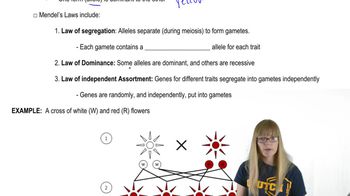Table of contents
- 1. Introduction to Genetics51m
- 2. Mendel's Laws of Inheritance3h 37m
- 3. Extensions to Mendelian Inheritance2h 41m
- 4. Genetic Mapping and Linkage2h 28m
- 5. Genetics of Bacteria and Viruses1h 21m
- 6. Chromosomal Variation1h 48m
- 7. DNA and Chromosome Structure56m
- 8. DNA Replication1h 10m
- 9. Mitosis and Meiosis1h 34m
- 10. Transcription1h 0m
- 11. Translation58m
- 12. Gene Regulation in Prokaryotes1h 19m
- 13. Gene Regulation in Eukaryotes44m
- 14. Genetic Control of Development44m
- 15. Genomes and Genomics1h 50m
- 16. Transposable Elements47m
- 17. Mutation, Repair, and Recombination1h 6m
- 18. Molecular Genetic Tools19m
- 19. Cancer Genetics29m
- 20. Quantitative Genetics1h 26m
- 21. Population Genetics50m
- 22. Evolutionary Genetics29m
2. Mendel's Laws of Inheritance
Mendel's Experiments and Laws
Problem 2
Textbook Question
Write a short essay that correlates Mendel's four postulates with what is now known about genes, alleles, and homologous chromosomes.
 Verified step by step guidance
Verified step by step guidance1
Start by introducing Gregor Mendel and his foundational work in genetics, focusing on his experiments with pea plants.
Explain Mendel's first postulate, the Principle of Paired Factors, and correlate it with the modern understanding of genes existing in pairs on homologous chromosomes.
Discuss Mendel's second postulate, the Principle of Dominance, and relate it to the concept of dominant and recessive alleles in genetics.
Describe Mendel's third postulate, the Law of Segregation, and connect it to the process of meiosis where alleles segregate so each gamete receives one allele from each pair.
Explain Mendel's fourth postulate, the Law of Independent Assortment, and relate it to the behavior of genes on different chromosomes assorting independently during gamete formation.
Recommended similar problem, with video answer:
 Verified Solution
Verified SolutionThis video solution was recommended by our tutors as helpful for the problem above
Video duration:
1mPlay a video:
Was this helpful?
Key Concepts
Here are the essential concepts you must grasp in order to answer the question correctly.
Mendel's Postulates
Mendel's four postulates, established through his pea plant experiments, describe the principles of inheritance. They include the concepts of unit factors (genes), dominance, segregation, and independent assortment. These postulates laid the groundwork for understanding how traits are passed from parents to offspring, forming the basis of classical genetics.
Recommended video:
Guided course

Mendel's Experiments
Genes and Alleles
Genes are segments of DNA that encode for specific traits, while alleles are different versions of a gene that can produce variations in those traits. For example, a gene for flower color may have a purple allele and a white allele. The interaction between alleles, including dominance and recessiveness, influences the phenotype expressed in an organism.
Recommended video:
Guided course

New Alleles and Migration
Homologous Chromosomes
Homologous chromosomes are pairs of chromosomes, one inherited from each parent, that carry the same genes but may have different alleles. During meiosis, these chromosomes undergo segregation, ensuring that gametes receive only one allele from each gene pair. This process is crucial for genetic diversity and is directly related to Mendel's principle of segregation.
Recommended video:
Guided course

Chromosome Structure

 8:06m
8:06mWatch next
Master Mendel's Experiments with a bite sized video explanation from Kylia Goodner
Start learningRelated Videos
Related Practice


